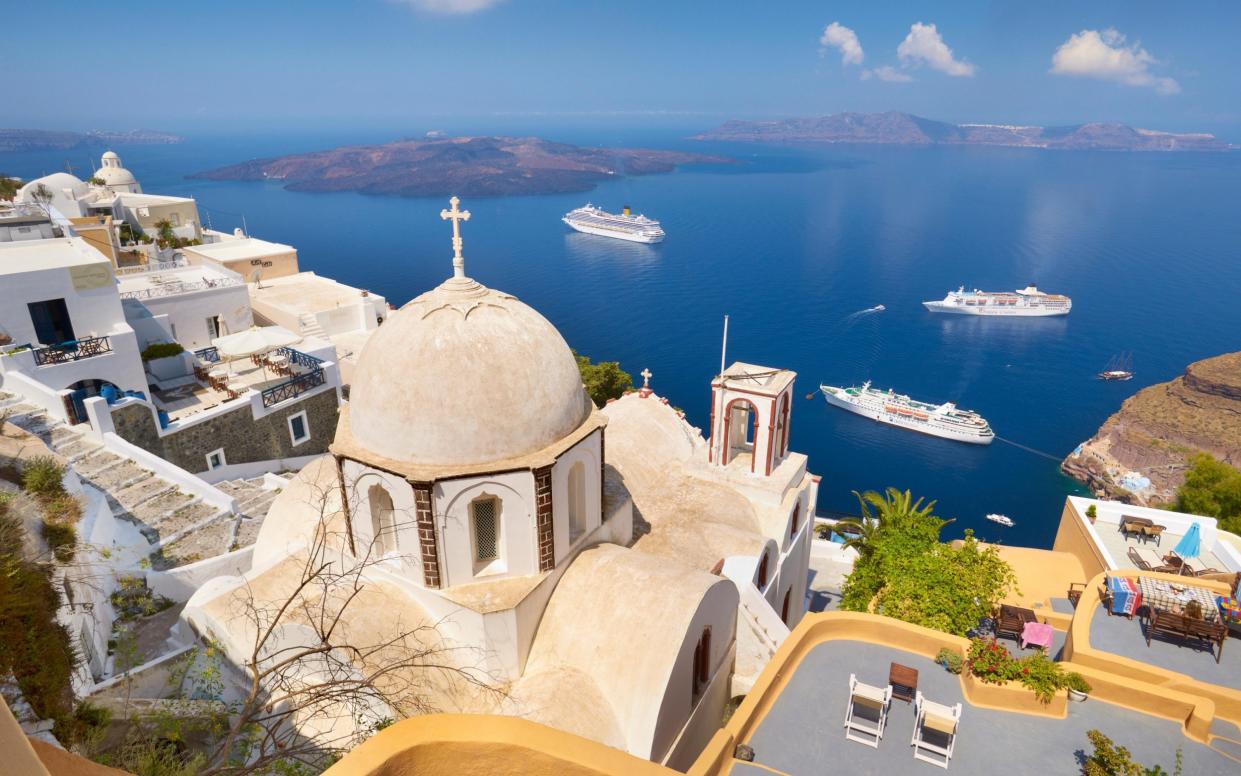Greece to cap number of cruise ships to Santorini and Mykonos

Greece will start restricting the number of cruise ships that visit places like Santorini and Mykonos, as tiny islands buckle under the increasing pressure of overtourism, the country’s prime minister said on Friday.
New measures are to be introduced to reduce the number of cruise liners, which can disgorge thousands of passengers at a time, said Kyriakos Mitsotakis.
“I think we’ll do it next year,” he said, referring to a plan to cap the number of cruise ship visits. The number of berths or anchoring slots could be reduced, he said.
The islands that are “clearly suffering” most are Mykonos and Santorini, he said.
Last year, nearly 750 cruise ships visited Mykonos, an increase of 23 per cent compared to the year before.
“Santorini is the most sensitive, Mykonos will be the second,” the prime minister told Bloomberg.
Cheap flights fuel tourism surge
A post-pandemic rebound has been key to Greece’s economic recovery in the wake of the grim years of austerity and cuts, but the sheer number of visitors is threatening to smother the more popular destinations.
Cheap flights and social media have fuelled the surge, as they have in so many parts of the world.
During the summer months, the whitewashed terraces and balconies that overlook Santorini’s extraordinary volcanic caldera are overrun with selfie-taking visitors, desperate for the perfect sunset shot to add to their social media feeds.
Last year, 800 cruise ships visited Santorini, making the volcanic island the most popular cruise ship destination in Greece.
Santorini’s 15,000 inhabitants find themselves more and more squeezed by the sheer weight of visitors, receiving 5.5 million tourists each year, a figure which has doubled since 2012.
“Santorini in itself is a problem,” said Mr Mitsotakis. The huge number of vessels docking at the island may not bring commensurate economic benefit, he said.
If Greece’s more popular islands become too overcrowded, then tourists will be dissuaded from visiting them because the experience will be ruined.
“There are people spending a lot of money to be on Santorini and they don’t want the island to be swamped. Plus, the island can’t afford it, even in terms of security,” the prime minister said.
Mykonos has also become saturated with tourists amid complaints of overdevelopment of the coast and outrageous prices at swanky beach bars and boutique hotels.
Urgent need to curb rampant construction
Greece is heavily dependent on tourism – it accounts for more than a quarter of the country’s economic output.
Tourism revenues are expected to bring in 21 billion euros this year, up from 20.5 billion last year.
Last year, nearly 33 million tourists visited the country, an increase of 18 per cent on 2022, drawn by turquoise bays, guaranteed sunshine, sandy beaches and sugar cube island architecture.
The summer season is only just getting under way but in the first quarter of the year there was already a 25 per cent increase in tourist numbers.
Greece’s ombudsman warned on Thursday that there is now an urgent need to curb rampant construction and protect coastal areas.
“Our country’s economy relies heavily on tourism which makes the need to manage it in a sustainable way even more urgent,” the ombudsman said.
Greece must not “exhaust its potential, wasting it and making our tourist destinations unattractive over time”, said its report, the first on the sector since the ombudsman was founded over 25 years ago.
The report singled out Santorini as having a particular problem with overtourism. “In Santorini, even tourists complain about the great number of tourists.”
Countries tackle overtourism
On the neighbouring Cycladic island of Paros, locals have protested against the rising number of privately-owned sunbeds and umbrellas that have sprung up on beaches that are supposed to be public and available to everyone. The government recently announced it will use Artificial Intelligence and satellite imagery to identify beach operators who abuse the permits they have been granted.
Countries around the world are debating whether the smothering effects of cruise ship tourism are justified from a social and economic point of view.
In 2021, Italy banned large cruise liners from using the Giudecca Canal that cuts through the heart of Venice.
Venice became the first city in the world to charge tourists an entrance fee in April, making visitors pay five euros each, with exemptions for anyone staying at least one night in a hotel.
There is opposition to giant cruise ships in Spain’s Balearic Islands, with locals complaining that passengers disembark for a few hours, spend little and then get back on the boat.
Islanders on Majorca are due to stage a fresh protest against mass tourism on Saturday, following previous demonstrations.
Earlier this month, a group of protesters crammed together on sarongs and towels on a beach on the island’s south coast to symbolise how they feel squeezed out by the 18 million tourists who visit Majorca each year.
In May, about 10,000 islanders marched through the streets of Palma, the capital, protesting against saturation tourism.

 Yahoo News
Yahoo News 
